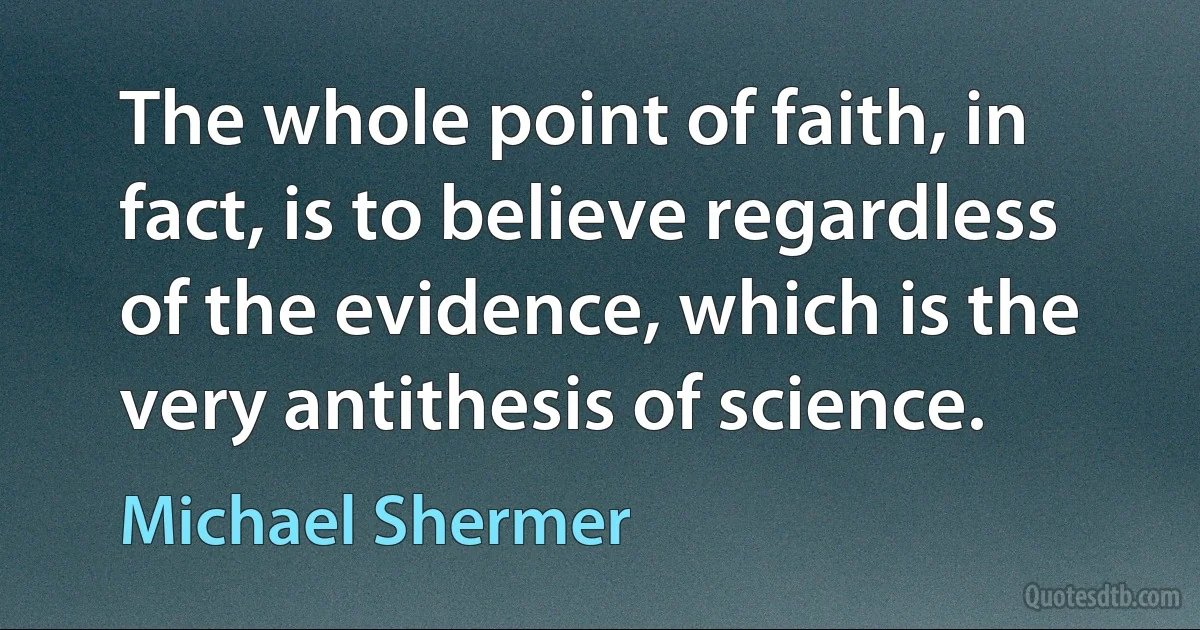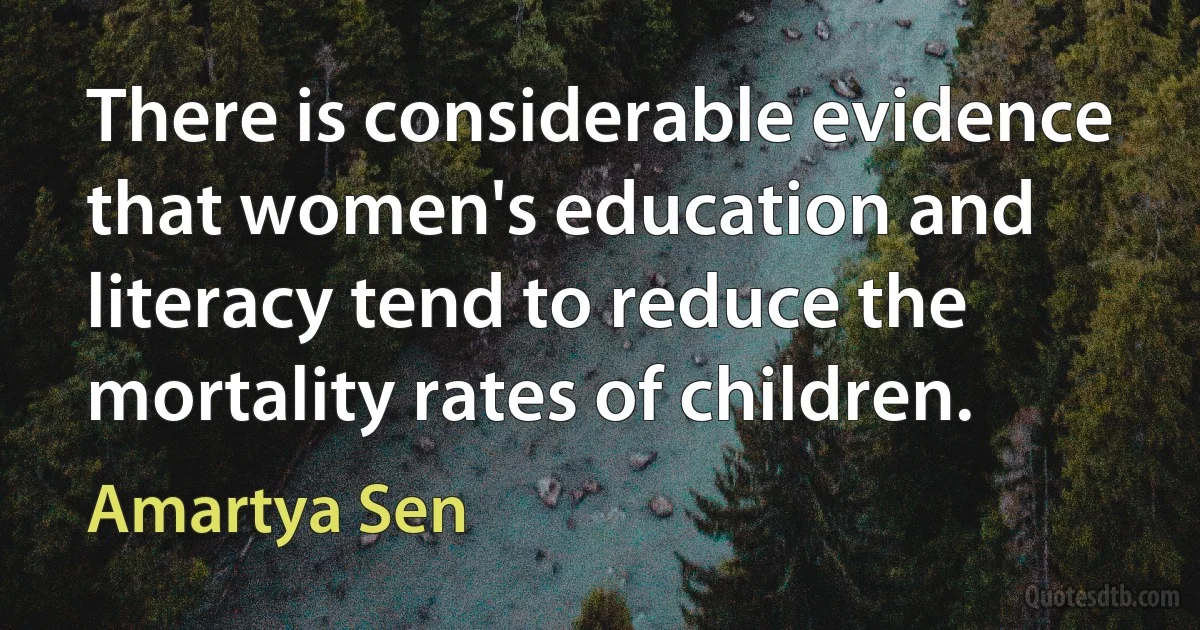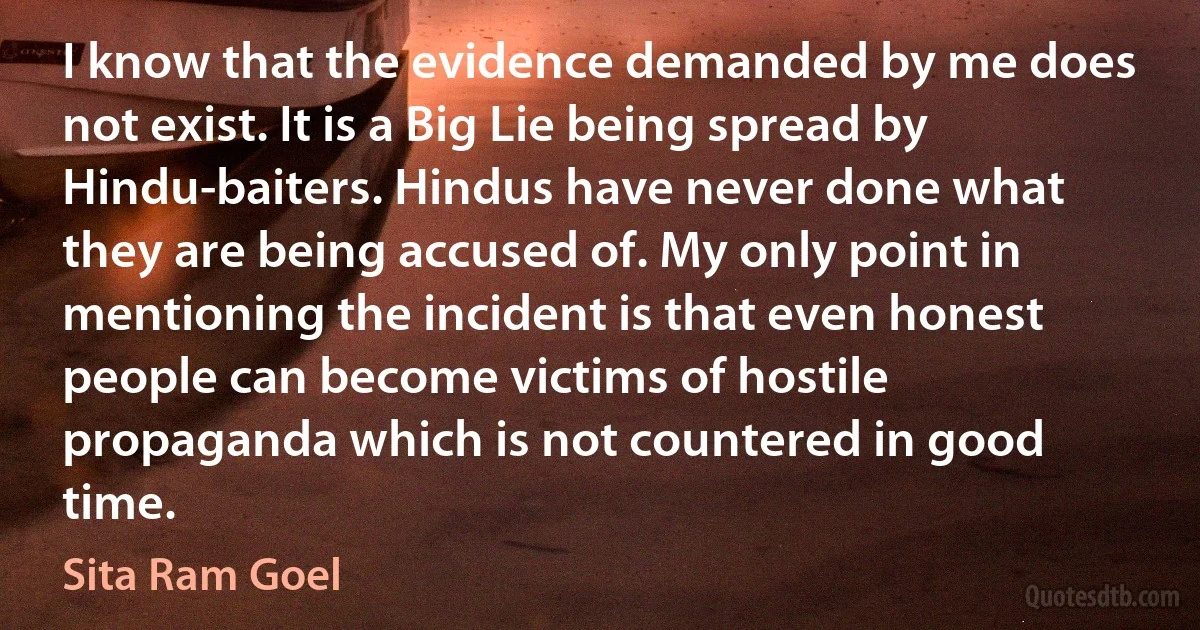Evidence Quotes - page 47
No one will deny or dispute the power of the Almighty to make such a communication, if he pleases. But admitting, for the sake of a case, that something has been revealed to a certain person, and not revealed to any other person, it is revelation to that person only. When he tells it to a second person, a second to a third, a third to a fourth, and so on, it ceases to be a revelation to all those persons. It is revelation to the first person only, and hearsay to every other, and consequently they are not obliged to believe it..... When I am told that the Koran was written in Heaven and brought to Mahomet by an angel, the account comes too near the same kind of hearsay evidence and second-hand authority as the former (Book of Exodus). I did not see the angel myself, and, therefore, I have a right not to believe it.

Thomas Paine
There are people who just don't believe in the existence of a god. I don't know why because clearly, there is strong evidence that there's a god. But I believe that you serve all the people, not just those who profess to have faith but those with little or no faith. That's how you convert them.

Donna Brazile
For some reason, contemporary America believes that it can reject its uniquely successful melting pot to embrace a historically dangerous and discredited salad-bowl separatism. Is there any evidence from the past that institutionalizing sects and ethnic grievances would ensure a nation's security, prosperity, and freedom? America's melting pot is history's sole exception of e pluribus unum inclusivity: a successful multiracial society bound by a common culture, language, and values. But this is a historic aberration with a future that is now in doubt...

Victor Davis Hanson
In history, one gathers clues like a detective, tries to present an honest account of what most likely happened, and writes a narrative according to what we know and, where we aren't absolutely sure, what might be most likely to have happened, within the generally accepted rules of evidence and sources.

Victor Davis Hanson
A rational process is a moral process. You may make an error at any step of it, with nothing to protect you but your own severity, or you may try to cheat, to fake the evidence and evade the effort of the quest but if devotion to the truth is the hallmark of morality, then there is no greater, nobler, more heroic form of devotion than the act of a man who assumes the responsibility of thinking.

Ayn Rand
There must be no barriers to freedom of inquiry... There is no place for dogma in science. The scientist is free, and must be free to ask any question, to doubt any assertion, to seek for any evidence, to correct any errors. Our political life is also predicated on openness. We know that the only way to avoid error is to detect it and that the only way to detect it is to be free to inquire. And we know that as long as men are free to ask what they must, free to say what they think, free to think what they will, freedom can never be lost, and science can never regress.

Robert Oppenheimer
I have assumed my clear commitment to a Trinitarian orthodoxy was sufficient evidence that I have not intentionally ignored the role of the Holy Spirit. It may be true, however, that my work has been so Christ-centred, I may have given the impression that the Holy Spirit is an afterthought.

Stanley Hauerwas
The work organization of the new seam was, to us, a novel phenomenon consisting of relatively autonomous groups interchanging roles and shifts and regulating their affairs with a minimum of supervision. Cooperation between task groups was everywhere in evidence, personal commitment obvious, absenteeism low, accidents infrequent, productivity high. The contrast was large between the atmosphere and arrangements on these faces and those in the conventional areas of the pit, where the negative features characteristic of the industry were glaringly apparent. The men told us that in order to adapt with best advantage to the technical conditions in the new seam, they had evolved a form of work organization based on practices common in the unmechanized days when small groups, who took responsibility for the entire cycle, had worked autonomously.

Eric Trist
In Britain, journalists often view comparisons with our society going back two, three, or seven centuries as more relevant than comparisons going back two, three, or seven decades. Drunkenness centuries ago is more illuminating than comparative sobriety 30 years ago. The distant past, selectively mined for evidence that justifies our current conduct, becomes more important than living memory.

Anthony Daniels (psychiatrist)
If the professors fail to come out with answers to questions posed by us, and to present the evidence in support of their statements, we shall be forced to conclude that far from being serious academicians, they are cynical politicians hawking ad hoc or plausible explanations in the service of a party line. In fact, we shall be justified in saying that they are not Marxists but Stalinists. Marxism is a serious system of thought which offers consistent explanations. Stalinism, on the other hand, is an exercise in suppressio veri suggestio falsi in pursuit of a particular end.

Sita Ram Goel
The evidence ... is always an exercise in suppressio veri suggestio falsi. For instance, Aurangzeb's petty donations to 2-3 Hindu temples patronized by some pet Hindu courtiers, are played up with great fanfare. But his systematic demolition of thousands of Hindu temples and defilement of countless images of Gods and Goddesses, throughout his long reign, is never mentioned. Such pitiable attempts at pitting molehills of munificence against mountains of malevolence, go against all sense of proportion in judging a whole period of Indian history.

Sita Ram Goel
Islamic literary sources provide far more extensive evidence of temple destruction by the Muslim invaders of India in medieval times. They also cover a larger area, from Sinkiang and Transoxiana in the North to Tamil Nadu in the South, and from the Seistan province of present-day Iran in the West to Assam in the East. As we wade through this evidence, we can visualise how this vast area, which was for long the cradle of Hindu culture, came to be literally littered with the ruins of temples and monasteries belonging to all schools of Sanãtana Dharma-Bauddha, Jaina, Šaiva, Šãkta, VaishNava and the rest. Archaeological explorations and excavations in modern times have proved unmistakably that most of the mosques, mazãrs, ziãrats and dargãhs which were built in this area in medieval times, stood on the sites of and were made from the materials of deliberately demolished Hindu monuments.

Sita Ram Goel
Three conclusions can be safely drawn from a study of these 21 inscriptions. Firstly, the destruction of Hindu temples continued throughout the Muslim rule, from the date of its first establishment at Delhi in AD 1192 to its downfall with the death of the Mughal emperor Muhammad Shah in 1748. Secondly, the destruction took place all over India and was undertaken by rulers belonging to all Muslim dynasties, imperial as well as provincial. Thirdly, the destruction had no economic or political motive as has been proposed by Marxist scholars and Muslim apologists; it was inspired by religious zeal and regarded as a pious performance by Muslim kings and commanders, all of whom took considerable pride in it and sought blessing from Allãh and the Prophet. The iconoclasts, it may be added, have been idolised all along as paragons of faith, virtue, justice and generosity. These conclusions become clearer still when we come to evidence from Islamic literary sources.

Sita Ram Goel



